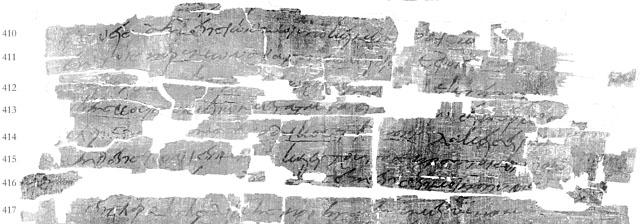
The Secret of the Koprodocheion
Archaeological and Papyrological Problems in the Carbonized Papyri from Petra.
CSAD, 5th December 2003.
The Petra carbonized papyri were discovered in December 1993 when a shelter was built for the protection of the mosaic floor of the Byzantine Church, excavated by the American Center of Oriental Research (ACOR). A rescue team under the leadership of Prof. Jaakko Frösén completed the opening and conservation of the carbonized rolls in 1995. The research and publication work was divided between two teams, one working under the leadership of Prof. Ludwig Koenen in Michigan, U.S.A., the other under Prof. Frösén in Helsinki, Finland. The first volume of the Petra Papyri, containing sixteen documents studied by the Finnish team, was published by ACOR in 2002.

Part of P.Petra inv. 88
My part in the publication project, papyrus P.Petra inv. 83, contains a document of ca. 500 lines where several disputed matters are settled between Theodoros, son of Obodianos, the central figure of the Petra papyri, and his neighbour Stephanos, son of Leontios, in the village of Zadakatha (modern Sadaqa), ca. 25 km southeast from Petra, probably in A.D. 574. The main body of the document consists of three pairs of speeches by the two parties, presented in the first person singular in a heated tone. At the end, there follows the decision given by two arbitrators and the signatures of all the four people connected with the process.
The matters disputed by the two neighbours contain many details which are interesting both from the point of view of archaeology and of legislation connected with buildings. The rainwater from the roof of Stephanos' house was led to Theodoros' roofs, and Theodoros had of old the right to use it. The water from Theodoros' roofs was led down by a spout (krounos) - built by him - to Stephanos' courtyard, where Stephanos again had the right to use it. New constructions built by Stephanos in his courtyard have led to a dispute over the water system of the houses. At the end, the old water rights of both parties are confirmed anew.
A central issue in the dispute is the division of a courtyard and the right to use a koprodocheion. This word is found in Greek sources only in the builder's manual composed by Julian of Ascalon (6th century), where it means a dry toilet. Here, it seems to be an important installation in the house, well worthy of litigation; it is near a street; it is connected with a courtyard; both parties claim to have the right to use it; both have a part of it, and Stephanos has busied himself with building and covering his part while Theodoros does not want to do this nor to let Stephanos go through his part. The exact nature of this installation is still unclear - it may be a large repository for all kinds of domestic garbage also used as a latrine, or perhaps a sewer, or a depository for dried dung to be used as fuel. At the end, the koprodocheion is divided between the parties in the ratio of two to one.
Another disputed matter concerns an alleged encroachment into Theodoros' property and theft of building materials from his house. Strong words describing total destruction of the buildings in question are used in the document. One might speculate that they refer to a previous earthquake in the fifties which would make the reuse of building materials understandable. Probably, however, it is merely a question of rhetorical exaggeration.
The fourth point in the decision concerns an old sale of a vineyard. A dispute had arisen some time earlier over a sum of two talents, and the phylarch Abou Cherebos had settled the matter. This probably refers to the Ghassanid Abu Karib, phylarch of Palestine since ca. 530. It is not unnatural that this infiuential personage would have been asked to play such a role in Kastron Zadakathon where he, as a military leader, would have been well known.
Maarit Kaimio, University of Helsinki
Return to Table
of Contents
Home | What's New | Events
| Images | Links
|

